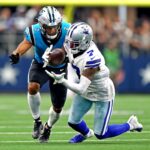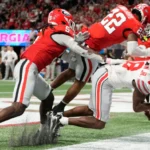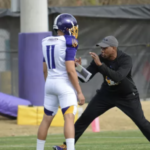Defensive backs (DBs) play a crucial role in preventing the opposing team’s passing game from gaining the upper hand. To do this effectively, DBs need to possess exceptional ball skills. Ball skills refer to the ability to track, catch, and defend passes, and they are an integral part of a defensive back’s skill set. In this article, we’ll explore some essential techniques and strategies that can help defensive backs improve their ball skills and become game-changers on the field.
1. Focus on Eye Discipline
The foundation of solid ball skills begins with maintaining proper eye discipline. Defensive backs must keep their eyes on the quarterback’s eyes and read his intentions. This allows them to anticipate the throw and react more quickly. Additionally, DBs should focus on the receiver’s eyes and hands as they progress down the field to gain insight into their route and when they might make a break for the ball.
2. Tracking the Ball
The ability to track the ball in flight is paramount for defensive backs. It involves maintaining good body positioning and fluidly moving in unison with the ball’s trajectory. To enhance this skill:
– Stay low and keep your hips down while backpedaling to maintain better balance and agility.
– Keep your arms relaxed and ready to react, extending them as you follow the ball’s path.
– Use your peripheral vision to keep tabs on the receiver while tracking the ball.
– Anticipate the flight path of the ball based on the quarterback’s body language and the receiver’s route.
3. Catching Techniques
Once you’ve tracked the ball successfully, the next step is to secure it. Here are some catching techniques to improve your ball skills:
– High-Point the Ball: When the pass is in the air, strive to intercept it at its highest point, increasing your chances of making a play on the ball. Elevate and attack the pass when it reaches its peak.
– Hands Placement: Keep your hands ready and positioned correctly to secure the ball. Use your fingertips and thumbs to create a basket shape, ensuring the ball doesn’t slip through your grasp.
– Hand / Eye Coordination: It is important that you see the point of the ball as it is approaching. Make that your focus and see it enter your hands. Many defensive backs take this for granted. Do not assume the catch. Be sure to actually see the ball enter into your hands to secure it.
– Hand Strength and Coordination: Strengthening your hands and fingers can greatly improve your ball skills. Exercises such as grip strength training and catching tennis balls can help enhance your hand-eye coordination. Simply gripping tennis or racquetballs repeatedly can do wonders for your grip strength.
4. Ball Disruption
While catching interceptions is a vital aspect of ball skills, preventing completions is equally important. DBs can disrupt passes and break up plays through various techniques:
– PBU (Pass Break Up): Timing is key when attempting to swat away or deflect a pass. Ensure you make contact with the ball right as it reaches the receiver’s hands to prevent the completion. Or you can deny the ball from the receiver’s hands by placing your off hand in front of the receiver’s hands as the ball approaches.
– Strip the Ball: If the receiver has caught the pass, look to strip the ball from their possession. This can lead to turnovers or incomplete passes. Work on punching through the basket (the area formed by the receiver’s arms to secure the ball in his possession).
5. Film Study
Improving your ball skills extends beyond physical practice. A deep understanding of offensive schemes, quarterback tendencies, and the receivers you’re covering can be a game-changer. Study film to identify patterns and anticipate plays, enhancing your ability to read the quarterback’s intentions and react more effectively.
6. Practice, Practice, Practice
As with any skill, repetition is essential for mastery. Incorporate regular ball skill drills into your practice regimen. Focus on various aspects, including tracking, catching, and disrupting passes. Repetition builds muscle memory and hones your instincts. As defensive backs, blind ball drills are an important part of your ball skills work. As defensive backs you will not often have the chance to see the ball thrown by the quarterback. Much of what defensive backs experience is seeing the ball already in mid-flight. More on ball drills in my book 101 DB Tips.
Defensive backs with exceptional ball skills can be the difference-makers in a game. By focusing on eye discipline, tracking the ball, refining catching techniques, employing ball disruption tactics, studying film, and maintaining a rigorous practice routine, you can take your skills to the next level. The ability to read and react to the quarterback’s passes and the receiver’s actions will not only help you make critical plays but also elevate your status as a standout defensive back in the world of football.
Chad Wilson is the owner of All Eyes DB Camp and author of "101 DB Tips". He played college football at the University of Miami and briefly in the NFL for the Seattle Seahawks. Over his 15 year high school football coaching career, he tutored over a dozen Division I defensive backs and as a trainer has worked with NFL All Pros, first round draft picks, college football All Americans and Top 10 ranked high school football prospects.








